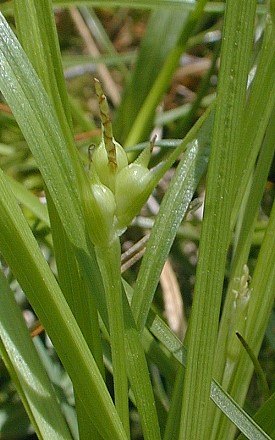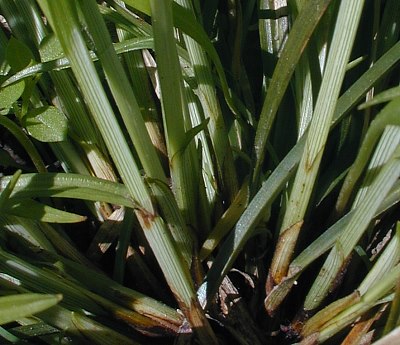Description:
This
perennial sedge consists of a dense tuft of vegetative shoots and
fertile
culms. The culms are shorter than the blades of the leaves. The culms
are about 2-4" long, light green, sharply 3-angled, and hairless; they
are slightly winged and rough-textured along their edges. Each culm has
several alternate leaves along its length; however, the lowest leaves
are primarily sheaths without blades. The widely spreading leaf blades
are up to 7" long and 3.5 mm. across; they are light to medium green
and glabrous. Each leaf blade is keeled/channeled along its length in
the middle. The two outer sides of each sheath are light green and
hairless, while the inner side of the sheath is membranous. Toward the
base of each culm, the sheaths become brown. Each culm terminates in a
tight cluster of 2-3 pistillate spikelets and a single staminate
spikelet. Each pistillate spikelet consists of a perigynium and its
pistillate scale. Each perigynium is about 5 mm.
long and 2.0 mm.
across; its apex consists of a beak about 2 mm. long, while its main
body is obovoid in shape (globoid with a wedge-shaped bottom). The
outer surface of an immature perigynium is light green and glabrous.
The pistillate scales of the perigynia are leafy in appearance; they
are typically 5-20 mm. long. The base of each pistillate scale is
slightly swollen; this is where its margins are membranous. Adjacent to
the perigynia, is a narrow staminate spikelet up to 8 mm. long. The
staminate scales of this spikelet have blunt or truncate tips with dark
brown margins; this provides the staminate spikelet with a banded
appearance. The blooming period occurs from mid- to late spring. The
pistillate florets of the perigynia are wind-pollinated. Inside each
perigynium, there is a small achene about 2.0-2.5 mm. long that is
globoid in shape and bluntly 3-angled. The root system is fibrous and
short-rhizomatous. This sedge spreads primarily by reseeding itself.
perigynium is about 5 mm.
long and 2.0 mm.
across; its apex consists of a beak about 2 mm. long, while its main
body is obovoid in shape (globoid with a wedge-shaped bottom). The
outer surface of an immature perigynium is light green and glabrous.
The pistillate scales of the perigynia are leafy in appearance; they
are typically 5-20 mm. long. The base of each pistillate scale is
slightly swollen; this is where its margins are membranous. Adjacent to
the perigynia, is a narrow staminate spikelet up to 8 mm. long. The
staminate scales of this spikelet have blunt or truncate tips with dark
brown margins; this provides the staminate spikelet with a banded
appearance. The blooming period occurs from mid- to late spring. The
pistillate florets of the perigynia are wind-pollinated. Inside each
perigynium, there is a small achene about 2.0-2.5 mm. long that is
globoid in shape and bluntly 3-angled. The root system is fibrous and
short-rhizomatous. This sedge spreads primarily by reseeding itself.
Cultivation:
The preference is partial sun to medium shade, mesic conditions, and a
fertile loamy soil. This sedge also tolerates drier and damper
locations. In relatively open areas, it forms a low spreading clump of
leaves and culms less than 1' tall. The leaves of the vegetative shoots
persist throughout the summer.
Range & Habitat:
The native James' Sedge occurs throughout Illinois and is fairly common
(see Distribution
Map). Habitats include rich mesic woodlands (typically
Maple-Basswood), wooded slopes, wooded groves (where the ground
vegetation is infrequently mowed underneath large trees), and edges of
woodland paths. Less often, this sedge may be found in upland woods and
swampy woodlands. It can be found in both high quality and somewhat
degraded deciduous woodland habitats.
Faunal Associations:
The foliage of Carex spp. (Sedges) is eaten by the
caterpillars of the butterflies Satyrodes eurydice
(Eyed Brown) and Satyrodes appalachia (Appalachian
Brown). The foliage is also eaten by leaf beetles (mainly Plateumaris
spp.), sedge grasshoppers (Stethophyma spp.),
and the caterpillars of several skippers (Euphyes spp.
& Poanes spp.). Leafhoppers that suck
juices from sedges include Cosmotettix bilineatus, Cosmotettix
luteocephalus, Cosmotettix marginatus,
and Elymana inornata. The seeds/seedheads of sedges
are an important source of food to many species of birds (see the Bird Table).
Which birds are likely to use a sedge species as a source of food
depends on the habitat (wetland, woodland, or prairie).

Photographic
Location:
A wooded grove at Chief Shemauger Park in Urbana, Illinois.
Comments:
James' Sedge is easy to identify because of the unique appearance of
its clustered spikelets. In particular, the pistillate scales are
unusually long and leafy, while the culms are unusually short. Perhaps
the most similar sedge is Carex wildenowii
(Wildenow's Sedge), which is found in southern Illinois. The perigynium
of this latter species tapers gradually from its main body to form a
long beak, while the perigynium of James' Sedge tapers abruptly from
its main body to form a long beak. Unlike James' Sedge, Wildenow's
Sedge has staminate scales with slender tips, and its pistillate scales
are smaller in size. Another common name of Carex jamesii
is Grass Sedge. This woodland sedge develops early in the spring and
blooms before the canopy trees have fully developed their leaves.